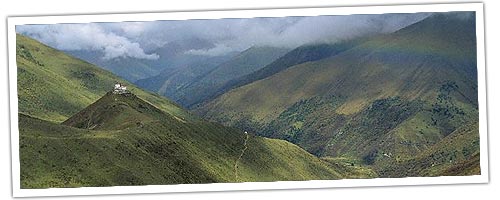Rajasthan Tour Package
» Royal Rajasthan Tour» Rajasthan India Tour
» Trip to Rajasthan
» Vacation In Rajasthan
» Rajasthan Tour Travel
more...
|
Spectrum Tours - offers information on Himalaya, Himalayan
Range, Parts of Himalayan Range, Greater Himalaya, Middle Himalaya -
Pir Panjal Range, Outer Himalaya - Dhauladhar
|


The Greater Himalaya stretches from Ladakh southward to Spiti and on to
Nanda Devi and Mount Everest in the east. The Western Himalayan which comprises
Lahoul, Spiti and Zanskar has an area of 7734 square kilometers, with the
altitude varying from 5000 metres to over 8500 metres. The Pir Panjal and
the Outer Himalaya also join the Greater Himalaya range at Kullu near Deo
Tibba (6001 metres) in Himachal Pradesh. Lahoul lies between these two Himalayan
ranges. The Zanskar range, which lies to the northeast of Lahoul, separates
the basin of Tibet from Himachal Pradesh. The western Himalaya, which includes
Kullu, Manali and Lahoul, is the gateway to adventure in Himachal. The resplendent
beauty of silvered summits, like those of Mulkilla massif (6518 metres),
Chandra Bhaga group of peaks (over 6500 metres), Phobrang (6173 metres),
Makarbeh (6070 metres) and Shikarbeh (6201 metres) makes climbing an unforgettable
experience. In the Kullu valley the peaks worth attempting are Hanuman Tibba
(5929 metres), Indrassan (6221 metres), Deo Tibba (6001 metres), Kullu Pumori
(6365 metres), Ali Ratni Tibba (5465 metres) among others. On the bank of
the Parvati river lies Manikaran, a place of pilgrimage for the Hindus with
hot water springs and ancient temples.
Middle Himalaya: The Pir Panjal
The mid Himalayan chain commonly referred to as Pir Panjal, ranges from
4500 metres to 6500 metres in elevation and is spread over an area of 3574
square kilometers. The Pir Panjal,
which joins the Dhauladhar at Barabhangal and Kullu, is by and large encompassed
by the Chenab and Ravi. The northern section is called Pangi and Chamba.
Lahoul is a fairly isolated region. This range forms a second barrier with
its peaks soaring beyond 6000 metres and the passes ranging between 4500
metres and 5500 metres.
Outer Himalaya: The Dhauladhar
The Dhauladhar, also known as the Lesser Himalaya, spreads from Dalhousie
in the Chamba district to Barabhangal and Kullu and is demarcated by the
river Beas to the south of Kullu. It has a mean height varying between 4000
metres and 5500 metres. The Outer Himalaya, which consists of the Kangra
district excluding Barabhangal area which is part of the central Himalaya,
has an area of 4066 square kilometers. To the north of the Shivaliks, the
fertile Kangra valley runs transversely for about half the length of Himachal
Pradesh. Behind this valley the first granite range of Dhauladhar rises
abruptly to over 4500 metres. Further north lies the Pir Panjal range and
then finally the Greater Himalayan range.
These three mountain ranges form the catchment area of Himachal Pradesh.
They run almost parallel to one another and serve as the sources of the
five main rivers of the state, the Beas, Sutlej, Ravi, Chenab and Yamuna.
The Beas originates from the Rahalla fall below Rohtang Pass and flows from
Beas kund, its ultimate source below Sitidhar range in the Kullu valley.
It divides Kullu from Lahoul and flowing southward it turns abruptly westward
and after traversing the district of Mandi, enters Kangra. The Ravi and
the Beas mark the boundary of Dhauladhar which spreads majestically over
the Shivaliks and acts as a barrier between Kangra and Chamba. The Beas
receives the drainage of the Kangra valley and then flows on to the plains
of Punjab. The Spiti river forms the drainage network of the Spiti valley
and joins the main -stream of the Sutlej at Khab below Shipkila. It springs
from the famous Mansarover lake in the highlands of Tibet. From there it
cuts across the Zanskar and the other Himalayan ranges at Shipkila forming
deep and steep gorges and flows into the Bhakhara where this mighty river
has been tamed by the Bhakhara dam and forms an artificial lake
Adventure
in Himalaya
Duration : 15 Nights / 16 Days
Destination
: Delhi -Mussoorie - Rishikesh - Corbett -Ranikhet - Binsar - Ramgarh
- Nainital - Delhi
Wildlife
in Corbett
Keeping in mind the adventurous nature of Sir
James Edward Corbett - the great environmentalist and hunter who fought
the epic battle against the man-eaters of Kumaon hills, (who had struck
terror between 1900-1950 and had claimed more than 2000 human lives) we
have design trips Which take you down memory lane to the times of probably
the world's greatest hunter of man-eating tigers.
Himalayas
Mountain Range
The Central Himalaya are the crown of Uttar
Pradesh and stand guard to the Upper Ganga plain. The mighty Himalayas
standing on the northern frontier of UP are highly rugged and have
difficult and precipitous slopes, horned peaks, serrated crests of high
ridges,
Himalaya
Trekking
The scale of the Himalayas makes them the ultimate
trekking destination for nowhere else is such exalted beauty matched with
such overwhelming remoteness. The sweeping arc of this mountain chain
provides goals for every visitor and in its unity it displays an amazing
variety of landscapes and a dazzling selection of contrasting scenes,
climates and cultures.
Adventure
in Kumaon
It is a land blessed with natural and cultural
diversity - a land where people still live with nature - a land where
trade once flourished between the great Himalayan Kingdoms. It is a land
of heritage, festivals and rituals - a land of snowfed rivers. It is
KUMAON.

| Make My Trip | Hotel Booking | Car/Coach Rentals | Indian Tour Packages | Lodges & Resorts |
| Holidays in India | India Holiday Packages | |||
| India Travel Destinations | Rajasthan Tourist Places | Tourism in India | Trekking in India | Wildlife in India |
| Home |
Sitemap | About
Us | Contact Us |
Travel Web Directory
Travel
Resources Copyright © Spectrum Tour |